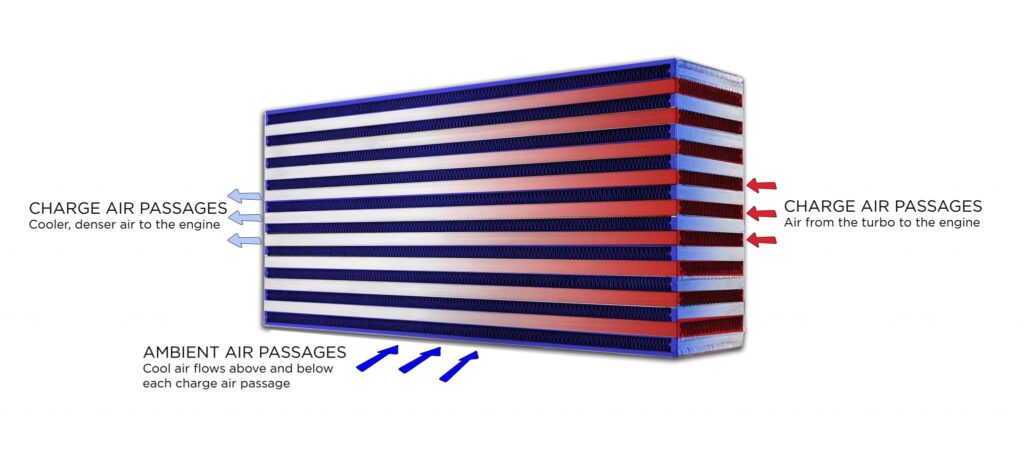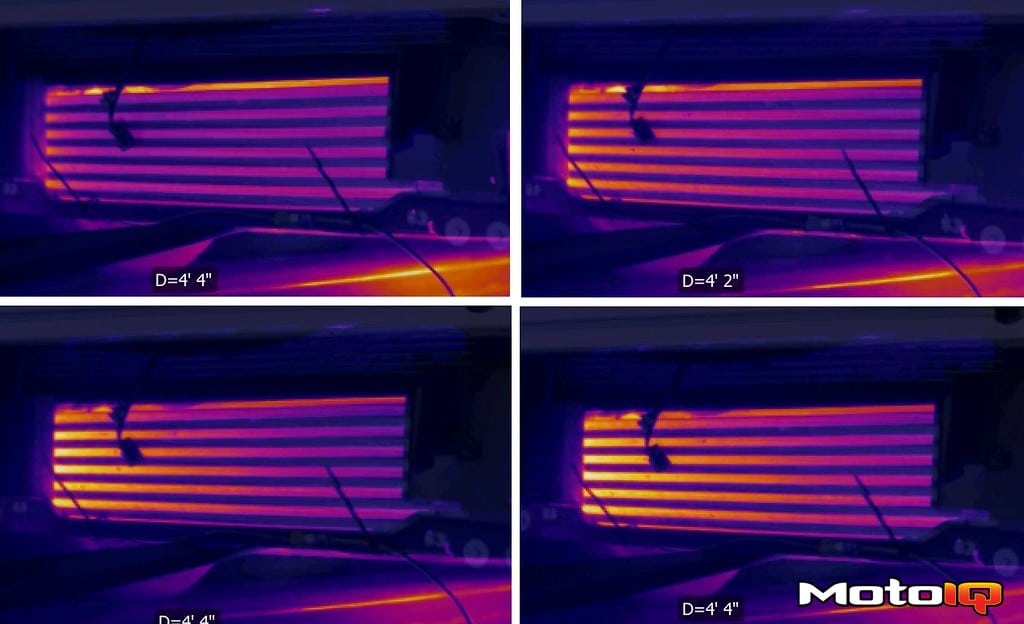Performance Intercoolers
Garrett performance intercoolers and intercooler cores work together with the turbocharger as part of the total induction system. When air is compressed in the turbocharger it gains a lot of heat. Hot air is less dense and therefore is not able to produce as much energy because less can be fed into the engines cylinders. The job of the intercooler is to remove heat from the charge air making it more dense. The denser charge equals more air and fuel reaching the engine and that translates to more horsepower.

Induction Sysytem Flow
In this diagram you can see the flow of the total induction system. As fresh air enters the compressor inlet, it flows through the compressor housing. Once discharged, the next stop is the intercooler. The air flows horizontally through the intercooler where heat is extracted. The cooler, higher density charge air then flows into the engine’s intake manifold and into the engine cylinders where it is mixed with fuel. The spark from the spark plug causes the mixture to combust. The air exits the engine through the exhaust manifold and into the turbine inlet where it is used to drive the shaft of the turbo.
Intercooler Construction
Garrett intercooler cores are bar and plate horizontal flow design. Charge air from the turbo flows within enclosed passages in one direction, with separate cooling passages flowing cooler ambient air in a perpendicular cross-flow pattern to the charge air. In bar and plate designs the passages consist of plates on top and bottom with fins in between. The passages are enclosed by bars on either side depending on if it is a charge air passage or an ambient air/cooling passage. Passages are stacked alternately until the desired stack height is reached. On the sides of the stacked cores, added to the final passage is a side plate of thicker material to provide structural integrity, protect the more delicate fins, and provide a surface for welding on end tanks if desired.

Heat Transfer
How does the intercooler remove heat from the charge air? There are three types of heat transfer modes, but the bar and plate intercooler relies on Conduction and Convection to extract heat from the charge air. Conduction is the transfer of heat to materials that have direct contact with each other. Convection is the transfer of heat from one place to another by movement of air. As you can see in the image below, the bars, plates, and fins alternate direction and flow and all play a part in extracting heat from the charge air. The charge air fins transfer heat from the charge air to the plates and the ambient air fins transfer the the heat from the plates and the ambient air cools the fins. The process repeats as long the car is moving or until the core gets heat soaked.

Selecting The Right Intercooler
We offer a wide range of air to air intercooler cores that are rated from 310 horsepower applications up to 1260 horsepower applications. Each core is rated for a specific horsepower, making it easy to match your desired power target to the core. In general, use the largest core that will fit within the packaging constraints of the application. For more information click the link below to visit the performance intercooler product page.
| Part Number | Hot Flow Length (in) | No Flow Height (in) | Cold Flow Width (in) | Core Weight (lbs.) | Horsepower* |
|---|---|---|---|---|---|
| 703518-6015 | 18 | 6.4 | 3 | 7.3 | 310 |
| 703521-6003 | 10 | 12.3 | 4.5 | 13.1 | 375 |
| 703520-6025 | 18 | 8 | 3.5 | 10.8 | 425 |
| 703518-6018 | 24 | 6.4 | 3 | 9.9 | 475 |
| 703520-6009 | 24 | 6.4 | 3.5 | 11.6 | 500 |
| 703518-6017 | 18 | 10.5 | 3 | 11.2 | 510 |
| 703520-6002 | 14 | 12.1 | 3.5 | 12.3 | 550 |
| 703520-6010 | 24 | 8 | 3.5 | 13.8 | 600 |
| 487085-6002 | 20 | 11.2 | 3 | 15.2 | 600 |
| 848054-0002 | 22 | 9 | 4 | 17.4 | 660 |
| 703522-6008 | 18 | 11.2 | 4.5 | 17 | 750 |
| 703518-6004 | 18 | 12.1 | 3 | 15.6 | 750 |
| 703522-6004 | 18 | 12.1 | 4.5 | 19.8 | 785 |
| 848054-0005 | 13.1 | 8.6 | 5 | 12.3 | 800 |
| 703520-6011 | 24 | 10.5 | 3.5 | 17.8 | 800 |
| 848054-6001 | 20 | 12.5 | 3.5 | 17.4 | 870 |
| 703518-6005 | 24 | 12.1 | 3 | 19.4 | 900 |
| 703520-6005 | 24 | 12.1 | 3.5 | 20.3 | 925 |
| 703522-6005 | 24 | 12.1 | 4.5 | 26.2 | 950 |
| 486827-6002 | 23.7 | 12 | 3.8 | 23.7 | 1000 |
| 848054-6003 | 22 | 14 | 4.5 | 26.4 | 1140 |
| 701596-6001 | 27.8 | 12.7 | 5.1 | 31.4 | 1260 |
* Horsepower rating shown for normal operating conditions, Maximum horsepower potential will be higher than the listed values.

